Baltra Island/Embarkation (AM) During World War II, Baltra served as a U.S. military base protecting the Panama Canal from enemy attack. Now the cactus-strewn landscapes of Baltra are home to the region’s main airport and where you will meet the ship. From the airport, it is just a short bus and tender ride to the ship.
Daphne Island (PM) Daphne is a satellite volcanic cone located north of Santa Cruz Island. The crater floor is an important breeding site for blue-footed boobies. The cliff shore of the island is home for sea lions, pelicans, blue-footed boobies, and tropic birds which can be observed during the circumnavigation of the island



Gardner Bay, Española Island (AM) A long white sand beach and clear blue waters make this an ideal spot for swimming, snorkeling, or just relaxing on the beach. In the water, sea turtles, rays, colorful tropical fish, sea lions and maybe even a white-tip reef shark may be seen. Excursion options: beach walking, swimming, or a deep-water snorkel for experienced snorkelers.
Suarez Point, Española Island (PM) Española is the oldest island in the Galapagos and home to an abundance of wildlife. At this site, visitors can expect to see sea lions, Galapagos Hawks, marine iguanas, and both blue-footed and Nazca boobies. Excursion options include a long, rocky walk to look for Waved Albatrosses (March to January), and observing an impressive blowhole that spews water like a towering geyser.
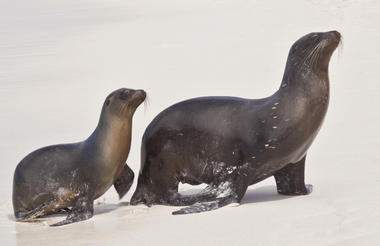
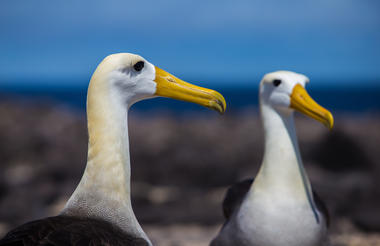
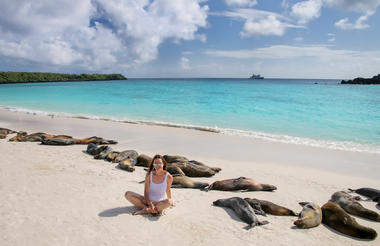
Cormorant Point, Floreana Island (AM) Floreana was the first capital of the Galapagos, and where Charles Darwin met the islands’ Governor. Its small brackish lagoon is often home to flamingos, stilts, and white-cheeked pintail ducks, and one of its beaches is a highly used nesting site for sea turtles. Check out the green-hued sand where you land! Excursion options include a relatively short walk to the lagoon and sea turtle nesting beach, and optional snorkeling and swimming at the landing beach.
Champion Islet (AM) This islet provides a wonderful opportunity for ocean adventures. When snorkeling, tropical fish abound with frequent sightings of sea turtles, rays, sharks, sea stars, and sea lions if they’re in a playful mood. On a coastal exploration ride along the rocky shoreline keep an eye out for seabirds such as boobies, pelicans, and frigatebirds. Red-billed Tropic birds nest in the crevices below prickly pear cacti. The rare Charles Mockingbird also makes its home here. Excursion option: advanced snorkel.
Post Office Bay, Floreana Island (PM) Rich in history, this site is home to the post office barrel established in about 1793, where pirates, buccaneers, whalers and others could leave their mail to be picked up by outbound ships. The tradition continues today, as visitors leave addressed postcards in the barrel and sort through left mail to deliver at home.
Baroness Overlook, Floreana Island (PM) The Baroness’ Viewing Point is the ideal place to take in the unique scenery that defines Floreana, and to learn about the intriguing history of the island, once inhabited by an indulgent baroness and her three lovers. During the coastal exploration ride around “La Loberia,” you can observe several marine species such as golden eagle rays, sea turtles, sea lions, mullets and occasionally Galapagos penguins.



Moreno Point, Isabela Island (AM) Along this beautiful rocky shore, a field of hardened black lava flows is pockmarked by shallow pools, which are home to shorebirds and flamingos. The mangrove-lined shore also provides a chance to see marine iguanas, sea turtles, stingrays, sharks, penguins, and the flightless cormorant. Excursion options: a long walk and coastal exploration ride, or an extended coastal exploration ride.
Urvina Bay, Isabela Island (PM) Composed of five merged volcanoes, this is the largest island in the Galapagos and the most recently active, the latest eruption having occurred at Wolf Volcano in 2015. Here you will see large land iguanas, finches, and if lucky, a giant tortoise or two. In 1954, magma from one of the island’s volcanoes caused part of the bay to be uplifted some 6 meters, allowing you to walk through the remains of what was once a thriving underwater reef. Excursion options: Walk, hike, snorkel, swim.



Espinoza Point, Fernandina Island (AM) Fernandina is the youngest island in the Galapagos and, as Darwin wrote, it is “covered with immense deluges of black naked lava.” Along with its extraordinary black lava rocks, this point of land hosts the largest colony of marine iguanas in the Archipelago, along with sea lions and a nesting site for flightless cormorants. Excursion options: Walk, deep-water snorkel, hike.
Vicente Roca Point, Isabela Island (PM) The half-collapsed remains of an ancient volcano make for a spectacular setting at this site. Awe-inspiring cliffs, blue waters, and wildlife create a coastal exploration ride to remember as you search for sea turtles, penguins, fur seals, the flightless cormorant, marine iguanas, marine mammals, and the oddly shaped form of the elusive sunfish. Excursion options: coastal exploration, deep water snorkel.



South Plaza, Santa Cruz Island (AM) One of two islands off Santa Cruz, South Plaza was born of upheaval, uplifted during a geologic event. The rocky island is strewn with prickly pear cactus and home to land iguanas, marine iguanas, and a colony of sea lions. Our excursion here is a short walk to view wildlife, flora, and geology.
Dragon Hill, Santa Cruz Island (PM) Dragon Hill, or “Cerro Dragon,” is named after its population of land iguanas. The site offers a beautiful view of the landscape and two small brackish lagoons where flamingos and other shore birds occasionally feed. Along the trail, cross a beautiful “white forest” of Palo Santo (incense) trees and Galapagos cotton plants. Excursion options for this visit include a long walk and a short walk.
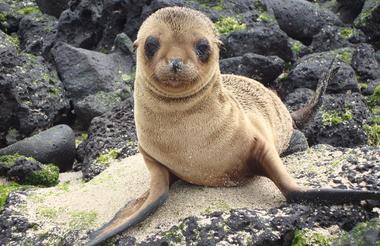


Puerto Ayora, Santa Cruz Island (AM) The main population center of the islands, Puerto Ayora is home to the National Park Service tortoise-breeding center and the Charles Darwin Research Station. You will be able to visit the breeding center and walk through the Research Station. You will also have the opportunity to take a bus ride to the highlands to observe giant tortoises in the wild and walk through a lava tunnel. In addition, you will have an exclusive opportunity to participate in the Scalesia reforestation project.

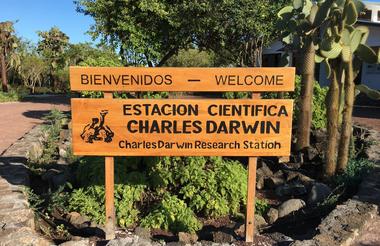
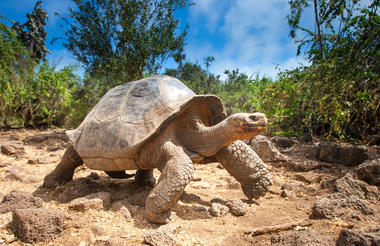
Breakfast
Lunch
Dinner
Baltra disembarkation / Airport transfer for flight home (PM)
Baltra is home to the region’s main airport, and where you will fly out after a tender and bus ride to the airport



Breakfast







